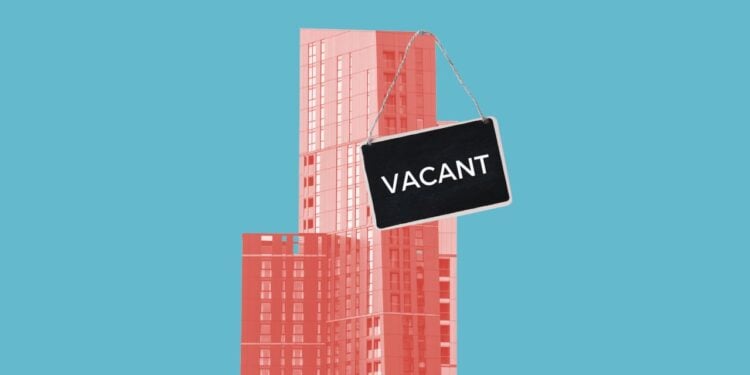- Office vacancies in America have been on the rise, reaching an all-time high due to factors such as remote work arrangements and the shift toward hybrid work models.
- As of the first quarter of 2023, the U.S. office market’s vacancy rate reached 17.8% — the highest in 30 years.
- This isn’t great news for the future of commercial real estate, and organizations need to consider restructuring their work models in order to cut costs.
Office vacancies in America have been on the rise, reaching an all-time high due to factors such as remote work arrangements and the shift toward hybrid work models.
As of the first quarter of 2023, the U.S. office market’s vacancy rate reached 17.8% — the highest in 30 years.
Office-using sectors of the labor market added 65,000 jobs in May, but their growth has slowed down for six consecutive months. The increase in vacancy rates has been more significant in main tech hubs like San Francisco, Portland, Seattle, and Denver, as many companies have migrated to more affordable places.
On the other hand, areas within a 2-hour commute of these main tech hubs experienced a decrease in office vacancy rates, as people continue to move to cheaper and warmer locations due to the popularity of hybrid work.
Overall, the trend in the office market remains weak, with nearly two-thirds of areas increasing their vacancy rates compared to before the pandemic. This isn’t great news for the future of commercial real estate, and organizations need to consider restructuring their work models in order to cut costs.
Allwork.Space asked Logan Nagel, Account Manager at Bullpen and Publisher of the Weekly Warmup, what all these office vacancies mean for the future of commercial real estate.
“Historically high office vacancy rates have a number of implications for commercial real estate as a whole. First is a continuation of the ‘flight to quality’ narrative, where new construction class A properties are faring markedly better than older stock. That trend is not going away any time soon,” Nagel said.
He says that tenants have many options when choosing a building to occupy, so landlords need to get more competitive, whether through concessions or upgrading the quality of the spaces themselves.
“Second, we’re seeing a nationwide dialogue about converting excess office space for other uses. The most talked about opportunity is converting old offices to rental housing,” Nagel told Allwork.Space. “This is absolutely happening already in cities across the country, but it can be hard for these projects to pencil. The costs are high, the expertise needed is great, and properties built to house workers in their cubicles often lack important characteristics that are important or required for rental housing, like adequate daylight penetration deep into each floor plate. One thing that could move the needle here is the arrival of incentive programs that make conversions less costly.”
Nagel gave the example of Portland, for instance, which approved an incentive program that will waive certain fees for office to residential conversion projects.
“Finally, office development pipelines have really been ground down by high materials costs, expensive debt, and fundamental weakness within the sector,” Nagel said. “Lower supply coming online could moderate some of the high vacancy we’re currently experiencing, but developers in the future might lean into more mixed use projects with more distributed risks.”
Allwork.Space also asked Dean Sison-Buenaventura, a Bullpen contract market researcher, why Savannah, Georgia in particular has such low office space.
“Savannah is situated in a desirable location and attracts plenty of visitors yearly. The Port of Savannah is one of the big contributors to the area’s economy. It has one of the lowest office vacancy rates across the nation,” he said.
Educational and medical users such as the Savannah College of Art and Design and St. Joseph’s/Candler Health System represent the largest office tenants in Savannah, according to Sison-Buenaventura.
“With that said, Savannah’s office market has low office space. This is due to the limited inventory/supply and rare large construction projects that come to fruition in the area. The market continues to sustain its rent growth and positive absorption,” Sison-Buenaventura told Allwork.Space. “There is a consistent demand for retail and hospitality, and construction is geared to both converting and demolishing office structures to meet those demands. With interest rates climbing upwards and economic uncertainty in place, office supply is likely to remain stagnant.”


 Dr. Gleb Tsipursky – The Office Whisperer
Dr. Gleb Tsipursky – The Office Whisperer Nirit Cohen – WorkFutures
Nirit Cohen – WorkFutures Angela Howard – Culture Expert
Angela Howard – Culture Expert Drew Jones – Design & Innovation
Drew Jones – Design & Innovation Jonathan Price – CRE & Flex Expert
Jonathan Price – CRE & Flex Expert












